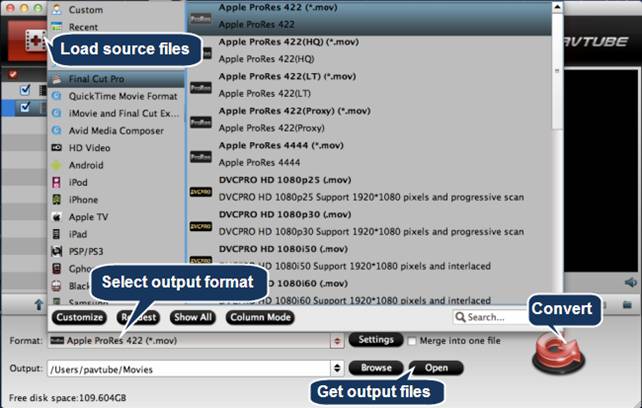Question:
"I'm using the non-linear editing Apple Final Cut Pro versions 6 and 7, as well as Avid Media Composer and try to import material (files MXF), filmed on camera Canon C300, Canon XF300 and Ikegami GFCam HDS-V10, but can not do it, t . K. said mounting systems "see" the data files. Is there a way to solve this problem?"
Answer:
MXF is an industry standard that is the standard "package" file. The problem is not that these mounting systems do not support this package, but the fact that, in its standard configuration does not support the codec MPEG-2 HD Long GOP 4:2:2, which is used in cameras Canon C300, XF305/XF300/XF105/XF100; Ikegami GFCam HDS-V10 and HDS-F90: and also camcorders Sony XDCAM Ruler.
Simply put, the reason lies in the nuances of how to support the codec, and in support of the correctness of the various types of "packages" of video files.
I note that for Final Cut is especially typical: Apple offers the user a "naked" system with a set of only "native" codec, other codecs to install on the system manually. You also need to add and support of "packages."
I am of the opinion that this is a typical marketing ploy, and quite successful, which on the one hand, to minimize the cost of the development and implementation of additional systems (CPU) or other processing of the codec. On the other hand, allows you to abstract the most problems, knitted with the correctness of processing video with varying degrees of coding, which can be attributed codecs MPEG-2 HD MXF (I-frame & Long GOP), H.264 (AVC HD, AVC-Intra), DVCPro HD, MPEG-2 HD MP4 (XDCAM EX), MPEG-2 SD (IMX), DV100 etc.
With the third party is a major opportunity to claim the payment from manufacturers of equipment for the implementation of the shooting support their formats and codecs (even if these formats are generally accepted and standardized), ie opens an additional channel of earnings.
Sometimes there are problems with editing systems Avid, although in their case the situation is much better: the vast majority of the MXF file support without additional plug-ins, so the problems with importing files MXF, obtained with Canon cameras and Ikegami, should not occur.
These problems are not the fault of the producers of film-making equipment, all claims should be addressed exclusively to developers and manufacturers of non-linear editing.
So now, how to solve this problem.
Here is an example for Final Cut Pro, as it is when it is used there is vast compatibility issues, but I will note at once that, in any case, the need to install additional third-party software and plug-ins, such is the policy of Apple.
In the case of Canon cameras to properly import the files into Final Cut Pro simply download the appropriate plug-ins from the official website of the company - it's plugins Canon XF Plugin for Final Cut Pro 1.2 or Canon XF Plugin for Final Cut Pro X 2.0.
For the same universal support for all types of MXF as in the past, as well as earlier versions of Apple Final Cut, there are two options.
Option 1:
This is the most logical, the best and convenient option, but also the most expensive.
To import and work with MXF files purchased a tool called Calibrated MXF Import, which is immediately after installation will effectively work with the files MPEG-2 MXF.
A complete list of supported formats shown below:
Ikegami GFCAM MXF File Formats
- I-Frame MPEG2 100Mb 1080/720
- Long-GOP MPEG2 50Mb 1080/720
- I-Frame MPEG2 50/40/30Mb SD
Canon MXF File Formats
- Long-GOP MPEG2 50Mb 1080/720
- Long-GOP MPEG2 25Mb 1080/720
Sony XDCAM MXF File Formats
- XDCAM HD (35Mb and 25Mb)
- XDCAM HD 422 (50Mb)
- XDCAM EX (converted from MP4 to MXF by Sony Clip Browser)
- IMX
- DV25
Panasonic P2 MXF File Formats
- AVC-Intra
- DVCProHD
- DV50
- DV25
Avid Media Composer MXF File Formats
- DNxHD
- AVC-Intra
- DVCProHD
- DV50
- DV25
- IMX
- 1-1
- 1-1-10b
- Meridien
Buy and download here perhaps.
The program has a test period of 30 days, which is quite correct: it allows you to pre-test the results and efficiency within a particular editing station and has to decide whether to purchase.
Option 2:
Over a long and difficult option, but it is quite cheap.
Use Pavtube MXF Converter for Mac - a professional Canon/Panasonic/Sony MXF converter / transfer MXF files to Apple Final Cut.
The principle of operation is as follows:
1. Download Pavtube Mac MXF Converter for FCP (download and purchase this converter here).
2. Installing the program and import the files into it MXF.
3. Select in the column formats desired output format for editing: for example, for efficient editing Canon MXF files or Ikegami MXF you can choose Final Cut Pro -> Apple ProRes 422 (*. Mov).

4. To edit the settings for conversion (the selection of audio track, output resolution, bit rate, etc.) you need to click "Properties" ("Properties").
5. Click on the button "Convert", wait for converting MXF files to Apple ProRes and then import the ProRes into the mounting system.
Which option to choose in the end, it's only you yourself.
The proposed methods are not universal solutions for all occasions and do not claim to such.
Read More:
- How to Play MP4 Videos in Windows Media Player?
- 3 Ways to Convert MKV to MP4 for iTunes Playing
- How To Convert MP4 X264 To AVI To Play On DVD Player?
- Rip 3D Blu-Ray Disc To 3D SBS MP4 For VR Headsets/3D TVs
- Best HD PVR Software To Re-Encode PVR Video To MP4/MKV/AVI
- Make 3D SBS MP4 Video For Homido VR


